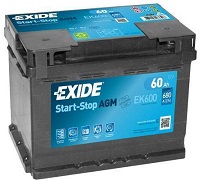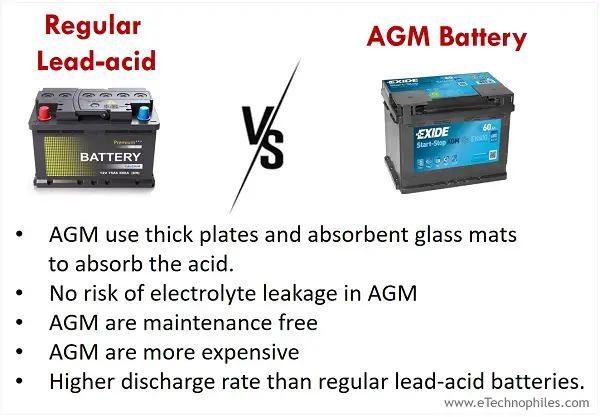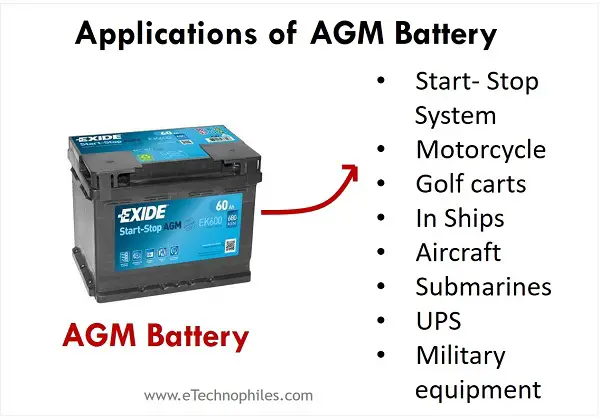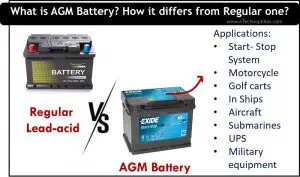Last updated on April 3rd, 2024 at 11:05 am
AGM stands for Absorbed Glass Mat. They are also called starved electrolyte batteries. Although the AGM batteries were invented in 1980, they were first brought to use in 1985 to meet the high power considerations of military aircraft.
These batteries are the top preference for automobiles that run power-hungry accessories. The start-stop application in today’s vehicles is also met by AGM batteries. These batteries also support the deep cycle feature with a maximum Depth of Discharge of 80%. High currents and a relatively long service life are the two key benefits of a battery.

Table of Contents
What does AGM mean?
The Absorbent Glass Mat (AGM) batteries are so called because they contain a separator made of fine glass fiber between the positive and negative terminals of the battery. This mat absorbs and holds all the battery acid up to about 95% of its capacity. This makes the plates (electrodes) and the mat held tight inside the battery. As a result, AGM batteries are spillproof and highly immune to vibrations.
AGM batteries are known as an advanced version of lead acid batteries due to this unique arrangement. It also helps enable easy shipment without hazardous material restrictions.
What is an AGM battery?
These are primarily lead-acid batteries. Some modifications and enhancements to the usual structure make these batteries different from ordinary lead-acid batteries. The design of AGM batteries makes them more resistant to damage from vibration and shocks, making them an ideal choice for use in motorcycles, golf carts, and other vehicles that experience high levels of vibration.
These are also a type of deep cycle batteries as they have thicker plates as electrodes. However, not all AGM batteries are deep cycles.
AGM batteries are mostly used as starter batteries rather than deep-cycle batteries. This is due to their capability to provide intense bursts of power. Since they have low input resistance and power-high loads, they are the best choice for vehicles that have high power-consuming electrical accessories.
AGM batteries are available in a variety of voltages that range from 6V to 12V. Each cell in a battery produces 2V. Most of the AGM batteries are available in moderate sizes that have a capacity ranging from 30 to 100Ah.
They offer good performance in cold temperatures but do not do well in the heat. A temperature above 49°C (120°F) is very dangerous for the battery life. Thus these batteries are usually installed away from the engine compartment of the vehicles. Another superior benefit is that more than 91% of these batteries are recyclable.
How AGM battery differ from a regular battery?

AGM batteries have significant differences from regular batteries. Here are the notable among them:
- The major difference is in their structure. Compared to regular batteries, they use thick plates and absorbent glass mats to absorb the acid.
- This structure helps them to withstand vibrations to a large extent.
- Since the acid is kept absorbed by the fibrous mat, there is no risk of electrolyte leakage. At the same time, the ordinary batteries are called “flooded” since the electrolyte moves freely inside the case.
- These batteries are sealed and are non-spillable. Making them maintenance-free and easier to install than regular lead-acid batteries.
- AGM batteries also have a higher discharge rate than regular lead-acid batteries, making them ideal for applications that require high-power output
- They are superior in active life performance.
- Due to all such benefits of AGM batteries, they are more expensive than regular ones.
Read also: What is a Solid-State Battery? Uses, Pros & Cons(Explained)
Applications

AGM batteries are one of the most highly utilized batteries today. Requirements like larger power output and longer active usage increased the demand for these batteries. Since the AGM batteries can be used both as a starter as well as deep cycle batteries, the requirements increased further. The most popular applications of AGM batteries are:
- To power the start-stop system of the vehicles. The start-stop vehicle automatically shuts down the engine whenever the vehicle stops. It also starts quickly when the pedal brake is released. So the battery must support quick and effort-free start and stop processes.
Note: The start-stop system works by automatically shutting off the engine when the car comes to a stop, and then restarting it when the driver presses the accelerator pedal. The start-stop system can help to save fuel by reducing idling time, and it also reduces emissions of pollutants.
2. To power high-drain electrical devices in automobiles such as heated seats, steering wheels, mirrors, windshields, etc.
3. To power electric devices in ships and for military applications where high power is necessary and frequent charging is difficult.
4. Used to power continuously working devices where frequent maintenance facilities are not available.
5. AGM batteries are designed to better withstand damage from vibrations and shocks, making them a great option for motorcycles, golf carts, and other vehicles that experience a lot of vibration.
Advantages
AGM batteries are adaptable to numerous complicated scenarios due to their remarkable advantages. Here are a few of them.
- Resistant to vibrations and shocks
- Highly sealed
- Spill-proof
- Capable of providing large current bursts and thus handling heavy loads
- Supports up to 80% DoD
- Recyclable up to 91%
- Environment friendly
- Incredible cycle life
- Maintenance free
- Good mounting flexibility
- Perfect for start-stop vehicles
- Withstands very low temperatures
Disadvantages
Apart from the notable benefits, these batteries have some limitations that reduce their demand in some applications. The disadvantages of AGM batteries are listed below.
- It is costly compared to regular batteries.
- The specific energy is relatively low.
- The capacity reduces gradually throughout its life.
- It is not suitable to store unused. Battery life is maintained if stored in the charged state or kept active.
- Severe damage occurs if overcharged.
- It is bulky and occupies a large space.
Conclusion
The battery occupies a vital position among the high-drain batteries in the industry. Being a starter as well as a deep cycle battery, numerous power applications are met by these lead-acid batteries.
They are the favorite choice in the automobile sector as it is free from the risk of spillage and demand less maintenance. The customer demand for these batteries will further increase once they become available at cheaper rates.
